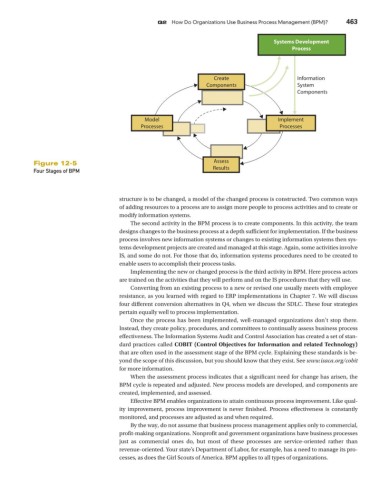Page 495 - Using MIS
P. 495
Q2 How Do Organizations Use Business Process Management (BPM)? 463
Systems Development
Process
Create Information
Components System
Components
Model Implement
Processes Processes
Figure 12-5 Assess
Four Stages of BPM Results
structure is to be changed, a model of the changed process is constructed. Two common ways
of adding resources to a process are to assign more people to process activities and to create or
modify information systems.
The second activity in the BPM process is to create components. In this activity, the team
designs changes to the business process at a depth sufficient for implementation. If the business
process involves new information systems or changes to existing information systems then sys-
tems development projects are created and managed at this stage. Again, some activities involve
IS, and some do not. For those that do, information systems procedures need to be created to
enable users to accomplish their process tasks.
Implementing the new or changed process is the third activity in BPM. Here process actors
are trained on the activities that they will perform and on the IS procedures that they will use.
Converting from an existing process to a new or revised one usually meets with employee
resistance, as you learned with regard to ERP implementations in Chapter 7. We will discuss
four different conversion alternatives in Q4, when we discuss the SDLC. These four strategies
pertain equally well to process implementation.
Once the process has been implemented, well-managed organizations don’t stop there.
Instead, they create policy, procedures, and committees to continually assess business process
effectiveness. The Information Systems Audit and Control Association has created a set of stan-
dard practices called COBIT (Control Objectives for Information and related Technology)
that are often used in the assessment stage of the BPM cycle. Explaining these standards is be-
yond the scope of this discussion, but you should know that they exist. See www.isaca.org/cobit
for more information.
When the assessment process indicates that a significant need for change has arisen, the
BPM cycle is repeated and adjusted. New process models are developed, and components are
created, implemented, and assessed.
Effective BPM enables organizations to attain continuous process improvement. Like qual-
ity improvement, process improvement is never finished. Process effectiveness is constantly
monitored, and processes are adjusted as and when required.
By the way, do not assume that business process management applies only to commercial,
profit-making organizations. Nonprofit and government organizations have business processes
just as commercial ones do, but most of these processes are service-oriented rather than
revenue-oriented. Your state’s Department of Labor, for example, has a need to manage its pro-
cesses, as does the Girl Scouts of America. BPM applies to all types of organizations.

